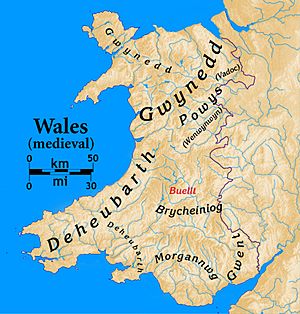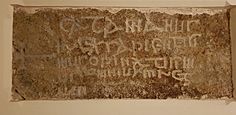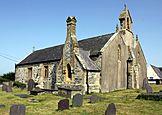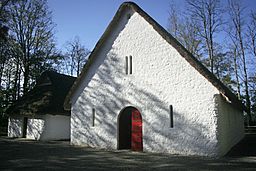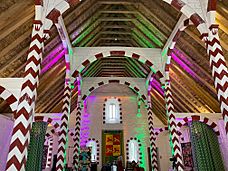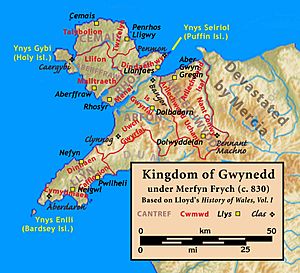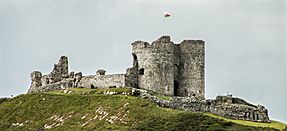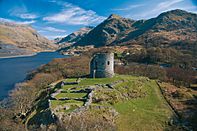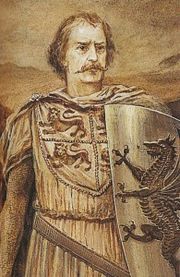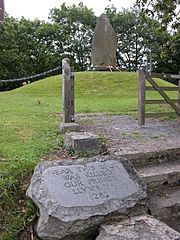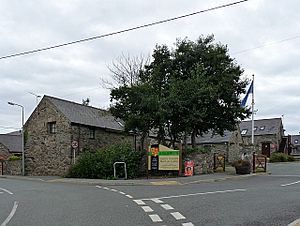House of Aberffraw facts for kids
| House of Aberffraw |
|||
|---|---|---|---|
Quick facts for kids 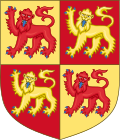 Traditional Arms of the Aberffraw House of Gwynedd |
|||
| Country: | Wales | ||
| Parent House: | House of Gwynedd | ||
| Titles: |
|
||
| Founder: |
|
||
| Final Ruler: | Dafydd III | ||
| Current Head: |
List
Disputed since 2022:
|
||
| Founding Year: | c. 390 | ||
The Royal House of Aberffraw (Welsh: Talaeth Aberffraw) was a cadet branch and capital of the medieval Kingdom of Gwynedd. The dynasty began in the 9th century, starting with Rhodri the Great who had built a Palace at Aberffraw, he named his eldest son Anarawd ap Rhodri as the heir of the King of Wales. The re-establishment of a Royal Court (Welsh: Llys) at the former Aberffraw commote, Anglesey (North Wales, UK) began a new era for the royalty of Wales. The area was once a royal demesne. The administrative region of Southwest on the Isle of Anglesey was split into two commotes of Malltraeth and Llifôn.
Members of the House of Aberffraw family achieved the recognised royal titles of King of Wales, Kings or Princes of Gwynedd, the Prince of Wales and were sometimes named the Kings, Princes or Lords of Aberffraw and also Lords of Anglesey and Eryri.
Definitive carbon dating has proven a presence at the former royal court (Llys) between the 1st century and the 4th AD. It also shows a permanent settlement before, during and after the Roman conquest of Anglesey. With the Romans came the religion of Christianity and St Beuno's Church. The Aberffraw church was built as a place of worship in the 12th century and is still being used today. Prior to Sub-Roman Britain, the Celtic inhabitants of Wales were religiously Pagan, and they had Druid priests.
The Aberffraw Palace (Llys) was in use by members of the Welsh Royal family for nearly 400 years between the 9th to 13th centuries and was the capital of Wales for a period of that time. It was during 1283 that the final named heir of the Kingdom, Dafydd ap Gruffydd (Dafydd III), broke his ties with Edward I of England. Dafydd III was then tried and committed for treason. This left a void in the Aberffraw dynasty. As of the 13th century onwards, there were no more direct heirs to rule the Principality of Wales. Over a century later, and several rebellions later when the Aberffraw family's senior male line ended, Owain Lawgoch was the last direct male descendant of the Aberffraw dynasty. He died childless in 1378.
When Aberffraw is mentioned, the royal familial branch explains a historiographical and genealogical term historians use to illustrate the clear line of succession from Rhodri the Great of Wales through his eldest son Anarawd.
Contents
- Roman occupation of Britain
- Royal court (Llys)
- Founding of the Aberffraw dynasty (873)
- Cambro-Norse era, 850s-c. 1100s (Viking raids)
- Welsh power base (Norman invasion)
- Welsh castles and expansion
- Welsh Principality: Prince of Wales (Welsh rule, 1216 – 1283)
- Demise, consequences and succession
- After the Dynasty
- Biographical sources online
Roman occupation of Britain
The Roman conquest of Britain began in 55 BC and ended in 410 AD. During this period, the Celtic British Kingdoms were established throughout Great Britain. The Celtic tribes resisted the Roman invasions for over a century, however, the turning point was in 52 AD when the leaders of the tribes surrendered to the Roman Emperor, Claudius who had previously invaded less than a decade before. Britain (Britannia) was divided into 4 provinces ruled by Governors.
During the Roman occupation of Wales, Anglesey was invaded twice. The first conquest was around 60/61 AD, the Druid Welsh Celtic Ordovices (they did not submit to Claudius) tribe were decimated by Gaius Suetonius Paulinus and his Roman forces at Castell Bryn Gwyn, a hillfort near present-day Llanidan. In retaliation, the Welsh Ordovices tribe had attacked and almost destroyed the Roman cavalry stationed in North Wales, but Anglesey was again invaded in 77 AD. The next time it was the Roman Governor Gnaeus Julius Agricola and the XX Legion who travelled to North Wales to battle the Welsh tribe the Ordovices. Agricola defeated the tribe in 78 AD.
On the Isle of Anglesey at the now former Aberffraw Palace was a settlement during the Roman period in Britain. Sherds of Roman pottery were radiocarbon dated to be from between the years 27 – 387 AD. The Aberffraw Llys was excavated during 1973-74, 1979 & 1987-88. The palace excavated was previously occupied for millennia before AD, from a prehistoric settlement, until 1317.
Post-Roman Welsh Kingdoms
After the Roman occupation (c. 400s), the original tribal boundaries of Wales were changed. This was when tribal Wales was divided into four kingdoms: The Kingdom of Gwynedd (north), The Kingdom of Powys (east), The Kingdom of Gwent (south), and The Kingdom of Deheubarth (west). Of the original 4 Welsh Kingdoms, Gwynedd's Mona (Anglesey) settlement of Aberffraw was the location of the Princes of Wales' principal seat.
Historically, the Welsh Royal Family of Aberffraw descended from Sub-Roman Britain and Kingdom of Gwynedd (Medieval Latin: Venedotia). The founding member and ancestor of the Kings of Gwynedd was the King Cunedda (b. 380s). He was a Roman soldier who came from Manaw Gododdin which is modern Clackmannanshire, Scotland to Gwynedd in 401. Cunedda's grandmother was Conan Meriadoc's granddaughter (King of Dumnonia, modern-day Cornwall), heir of the legendary Governor of North Cambria (North Wales) and King of Britain, Eudaf Hen. With help from the Roman Emperor, Magnus Maximus (Welsh: Macsen Wledig, c. 383), Conan was given the fellow Celtic nation, Armorica in Celtic Gaul territory (modern Northwest France) for him to rule. Cunneda's grandson, Cadwallon Lawhir (c. 443 AD) established a residence on Anglesey and helped to repel the Irish Celts who invaded the island.
Post-Roman Christian Anglesey
After the occupation of the British Isles by the Romans there were numerous Roman roads and forts built throughout England and Wales. Also, churches were founded. The original Roman religious centres established centuries prior were still in use after the occupation of Britain. Many survived until the 6th century. An example of the founding of Christianity in Wales was how during the 3rd and 4th centuries, the Romans built a military outpost on Mona (Anglesey), not too far from Aberffraw, at Holyhead, on Holy Island. The fort Caer Gybi was later given to Saint Cybi, he transformed it into a church in the 6th century. St Cybi's Church has been adapted several times and is still used today.
Christianity was established in Britain in the 3rd century. After the 6th century, new churches were built throughout England and Wales, some of which still survive today. Wales' patron is Saint David (d.589). By the 7th century, the penultimate King of Britain Cadwallon ap Cadfan (also King of Gwynedd) became a monk at the monastery at what is now St Cadwaladr's Church in the village of Llangadwaladr. The church is less than a mile in distance from Aberffraw. His son Cadwaladr abdicated as the final King of Britain (Welsh: Brenin y Brythoniaid), retired to Brittany and died in Rome in 703. Cadwallon's father, Cadfan ap Iago's (d. 625) tombstone is still in the church. The Catamanus Stone is on the north wall in the church and reads in Latin: CATAMANUS REX SAPIENTIS MUS OPINATISM US OMNIUM REG UM, in English: King Cadfan, the Wisest and Most Renowned of All Kings. During c. 620 AD, Cadwallon moved the royal court of Gwynedd from Aberffraw to Caernarfon because of the occupation of Irish Picts on Anglesey.
Aberffraw's church, St. Bueno's is dedicated to the Welsh Saint Beuno Gasulsych (died 642). Bueno was a contemporary of King Cadfan ap Iago. The current Church was first built in the 12th century, enlarged in the 16th century, and then remodelled in the 1840s and is still used today. Hugh Williams was the priest between 1754 – 1779. Today, the church is the principal monument in the village at the mouth of the river Afon Ffraw and is still used as a place of worship by the local community.
Royal court (Llys)
Aberffraw Llys acted as the capital of the Kingdom of Gwynedd, the Princes would live and entertain at their royal courts. They normally had a preferred palace as a base for the royal court, the court would move from one location to another, most of which are now unknown and were replaced by fields for farming or villages after the conquest of Edward I of England from 1277. With the Aberffraw Royal Court situated on Anglesey, the other local Royal Courts (Welsh: Llysoedd) were Llys Llanfaes, Cae Llys Rhosyr, Caer Gybi, Cemaes (Cemais), Talebolyon (Tal-y-Bolion), Penrhos (Penrhoslligwy). The Lords of Aberffraw also held the title of Prince of Gwynedd and would travel over the Menai Strait to the Welsh mainland, normally to the mountain range of Snowdonia and the surrounding area to perform the duties of the court and also to entertain dignitaries. In Gwynedd and the surrounding counties, the royal court would tour castles and courts with historic importance to the Kingdom and its allies. These locations were Llys Caer Segont (Segontium) the original Roman fort of the area; Cantref Arfon, where Caernarfon castle was built; Dolbadarn castle, Llys Dinorwig, which is now a town; Llys Aber (Garth Celyn) now named Pen y Bryn in Abergwyngregyn, which became the capital of the Kingdom of Gwynedd after Aberffraw and was the royal residence of one of the last Princes of Gwynedd, Llywelyn ap Gruffudd; Pen y Mwd, Degannwy castle (Din-Ganwy, Maelgwn Gwynedd's principal Llys c. 517), Llys Rhun, Caer-Rhun (Caer Ganwy) now a town and once the Roman fort Canovium; Trefriw, Bodysgallen a site once occupied by Cadwallon Lawhir ap Einion, King of Gwynedd; Rhos, and Rhuddlan another town in North Wales which was occupied by the Normans after the construction of Rhuddlan Castle.
The Aberffraw Palace (Llys)
During c. 1200, Prince Llywelyn the Great continued to convene the Royal court at Aberffraw to the high standard of the neighbouring English Kingdom. The Prince's consort was Joan, daughter of King John of England, herself being a Princess who would have entertained court at Aberffraw for Welsh and English royalty. Llywelyn as Prince re-edified the rules of the 'royal suite' which were reenacted from the original laws and customs from the year 914 for the Aberffraw Royal Palace. The palace was known as "the chief[e] house of the Prince of Gwynedd" from its foundations during the reign of Rhodri the Great.
There were 35 court positions: The Master of the Palace, The Domestic Chaplain / The Queen's Chaplain, The Steward of the Household / The Steward to the Queen, The Master of the Hawks, The Judge of the Palace, The Master of the Horse / Master of the Horse to the Queen, The Chamberlain / Queen's Chamberlain, The Domestic Bard, The Officer to Command Silence, The Master of the Hounds, The Metheglin (Mead brewer), The Physician of the Palace, The Cup Bearer, The Door Keeper, The Cook / The Queen's Cook, The Sconce bearer / The Queen's Sconce bearer, Woman of the Queen's Chamber, The Door-Keeper to the Queen, The Groom of the Rein, Officer to Support the Prince's Feet at Banquets, The Bailiff of the Royal Demesne, The Apparitor, The Gate-Keeper, The Watchmen of the Palace, The Woodman, The Baker Woman, The Palace Smith, The Laundress, The Chief of Song.
The setup of the Royal court was vast with a minimum of 47 positions necessary daily, and in some positions, multiple people would be needed. This extravagant setup is reminiscent of the opulence currently on display in the Royal Households of the United Kingdom, this is a retinue that follows King Charles III, himself a descendant of Llywelyn the Great. The hall at Aberffraw Palace would have been small. It was Llywelyn ap Gruffudd's room in Harlech Castle which was projected to be the same size as Aberffraw, 15 feet wide and 40 feet long. Aberffraw Palace (Llys) was dismantled in 1317, the wooden hall was carried from the Palace on Angelsey over the waters of Menai strait to Caernarfon castle for the Kings of England.
Founding of the Aberffraw dynasty (873)
Centuries after the Roman occupation of Britain, it was Merfyn Frych (c. 825 AD) who inherited the title the King of Gwynedd in Anglesey from his great uncle. Frych also inherited the neighbouring kingdoms. These inheritances came from the last direct male descendants of Cunedda Wledig, the first King of Gwynedd. Merfyn Frych's mother, Ethyllt (Gwynedd Princess) married Gwriad ap Elidyr, the King of Mann (Welsh: Ynys Manaw / Isle of Man). The Royal House of Aberffraw emerged centuries after the foundation of Gwynedd. The dynasty coincided with a wave of 9th century Saxon attacks around much of the British Isles. The founding of the Royal House of Aberffraw began with the family of Rhodri the Great. Rhodri was one of the sons of Merfyn Frych of the Kingdom of Gwynedd and a descendant of Cunedda who held the title of King of Wales. Merfyn was also a Manx chief. In the 9th century, Rhodri the Great had inherited Gwynedd from his father and Powys from his mother. He then added Seisyllwg (Ceredigion and Carmarthenshire) by a dynastic marriage to Angharad of Seisyllwg. In 873, Rhodri chose to return the Kingdom's principal (capital) royal court to the Aberffraw commote on Anglesey after 250 years away at Caernarfon, Gwynedd, mainland Wales. The location was chosen as a place to build the Welsh Royal family palace. The newly built royal court was where his descendants would rule Wales and the British Isles from. Rhodri was one of the first to hold the title of King of Wales (Welsh: Brenin Cymru) called the 'Cynethian line'. Before Rhodri Mawr succeeded to Aberffraw, his ancestor Cynan Dindaethwy would reside at court (Llys) on the opposite side of Anglesey, in the town of Llanfaes. The royal court was called Dindaethwy, in Rhosyr (cantref). The royal court was the centre of the commote of Menai until the 9th century.
Welsh Royal Houses
The Welsh Royal family (c.870s) were divided into 3 separate Royal Houses (Welsh: y Tair Talaith). The Royal Houses were founded by the sons of Rhodri The Great who used the Welsh custom of gavelkind to share his inheritance. The new cadet branches emerged in the 9th century. The division of land between siblings would shape Wales and gave rise to the Royal Houses of the Kingdom of Wales. Anarawd ap Rhodri (Rhodri's eldest son) started the House of Aberffraw on the Isle of Anglesey (Welsh: Ynys Môn) during the year 877 and made the location his early principal family seat in the Kingdom of Gwynedd (North Wales). The second son of Rhodri, Cadell ap Rhodri started the House of Dinefwr in the Kingdom of Deheubarth (South Wales) and thirdly House of Mathrafal would emerge in the Kingdom of Powys (Mid Wales). Of the 3, Aberffraw was considered the principal seat of Wales. Those 'Three Crowned Princes' were named 'Tri Tywysog Talaethog' in Welsh.
Succession
Royal succession within the House of Aberffraw (as with succession in Wales in general) was a complex matter due to the unique character of Welsh law. According to Hurbert Lewis, though not explicitly codified as such, the edling, or heir apparent, was by convention, custom, and practice the eldest son of the lord or Prince and was entitled to inherit the position and title as "head of the family" from the father. This was effectively primogeniture with local variations. However, all sons were provided for out of the lands of the father, and in certain circumstances so too were daughters (with children born both in and out of wedlock considered legitimate). Men could also claim royal title through the maternal patrimony of their mother's line in certain circumstances (which occurred several times during the period of Welsh independence). The female line of the dynasty was also considered to remain royal, as marriage was an important means of strengthening individual claims to the various kingdoms of Wales and uniting various royal families to that of Aberffraw, or reuniting factions after dynastic civil wars (for example with the marriage of Hywel Dda, a member of the Dinefwr branch of the Aberffraw dynasty, and Elen of Dyfed, daughter of Llywarch ap Hyfaidd, King of Dyfed).
Welsh laws
Around 945 AD, Rhodri's grandson, Hywel Dda would write the laws for the Kingdoms of Wales. The Cyfraith Hywel (English: laws of Howel) would shape society in Wales and also included rules for family succession by which the Welsh Kingdoms would select their designated heir based on the gavelkind system. This meant that only direct descendants who were male (patrilineal) heirs could inherit titles and lands of his family ancestors.
Cambro-Norse era, 850s-c. 1100s (Viking raids)
During the Cambro-Norse era (850s-1100s), Wales was subjected to Viking raids all throughout the country between 852 and 919 (the Jómsvíkinga saga refers to that period). An example of this pattern was with the Viking leader Ingimund who was expelled from Dublin and tried unsuccessfully to establish a base on Anglesey (c. 902), but instead left for Chester.
The Welsh Kingdoms had been subject to the Kingdom of Mercia from the 7th century onwards. This led to the construction of Offa's Dyke, a territorial land border between England and Wales built in the mid to late 8th century. However, war broke out against the English for decades from 853 to 892, this culminated in a victory for The Welsh Kingdoms of Gwynedd and Powys against the English Mercian and Wessex Kingdoms who had been assisted by Anglo-Saxons and Danes.
After successful battles for Rhodri the Great, (grandson of the King of Mann) against the Vikings (Anglo-Saxons and Danes), beginning with the death of 'Horn the Dane' (Viking leader of the 'New Dubliners') in 856, Rhodri was then killed in battle against the Saxon leader Ceowulf of Mercia in 878 AD. But the Welsh would avenge their King with a victory over the English Mercians at the Battle of the Conwy in 881. During this period, Rhodri Mawr's sons were dependent for protection from the Scandinavian York Viking mercenaries.
The second phase of Viking raids in Wales continued into the 10th century. Between the years 950-998, Wales saw raids, attacks and slave raids with a devastating Viking raid happening at Aberffraw in 968. King Maredudd ab Owain would pay the ransom for the return of Welshmen. Then the third phase of Viking raids would coincide with the Norman invasion of Wales during the 11th century. This era saw a new alliance between the Vikings and Aberffraw through the marriage of Gurffudd ap Cynan's father Cynan ab Iago to the daughter of a Norseman after he took refuge in the Kingdom of Dublin. After several attempts to retake Gwynedd from the Normans, Gruffudd eventually succeeded with assistance from Magnus Barefoot (King of Dublin, King of Norway and King of the Isles) in 1098 when they won the Battle of Anglesey Sound against the English Normans together.
Welsh power base (Norman invasion)
The family was able to assert their influence within Gwynedd, their traditional sphere of influence, but by the 11th century, they were ousted from Powys (Mid Wales) and Deheubarth (West Wales) by a series of strong rulers from the House of Dinefwr in Deheubarth by their dynastically junior cousins. However, under Gruffudd ap Cynan, Aberffraw was able to recover his heritage and position as Prince of Gwynedd from Norman invaders by 1100. Owain Gwynedd, Gruffudd ap Cynan's son and heir defeated King Henry II of England and the vast Angevin host in 1157 and 1166, which led to Owain being proclaimed as The Prince of the Welsh (Medieval Latin: Princeps Wallensium) by other Welsh rulers. This proclamation reasserted and updated the Aberffraw claims to be the principal royal family of Wales, as senior line descendants of Rhodri the Great. This position was further reaffirmed in the 12th century biography: The History of Gruffydd ap Cynan, written in Latin, the book was compiled during the life of his sons and was likely intended for an audience outside Wales. The significance of this claim was that the Aberffraw family owed nothing to the English king for their position in Wales and that they held authority in Wales "by absolute right through descent", wrote historian John Davies.
Members of the House of Aberffraw would include Idwal Foel, Iago ab Idwal, Cynan ab Iago, Gruffudd ap Cynan, Owain Gwynedd, Gwenllian ferch Gruffydd, Llywelyn the Great, Llywelyn ap Gruffudd, Dafydd ap Gruffydd, Madog ap Llywelyn and Owain Lawgoch.
Aberffraw Dynasty: Kings, Princes and Lords
The Aberffraw dynasty senior line represented a family who descended from royalty and was considered the King of Wales, also Kings and Princes of Gwynedd, these titles were borne of civil strife due to Anglo-Welsh wars. Aberffraw itself became a settlement and principal seat for the Princes of Gwynedd in Wales in the High Middle Ages. Llys Aberffraw would have acted as a power base for the most successful warlords in Wales' history, they conquered all of Wales and went to battle with the English, as typified in the signing of the Magna Carta which benefited Llywelyn the Great, the first official Prince of Wales. Their titles of 'Prince of Aberffraw', and 'Lord of Snowdon' were recognized by the English Crown, and the Prince of Gwynedd would receive payments of gold from their subjects. This was its golden age during the rule of Llywelyn ab Iorwerth who was recognised as ruler of all of Wales. The 12th-century court poet Llywarch ap Llywelyn addresses Dafydd ab Owain Gwynedd a son of Owain Gwynedd as 'Lord of Aberffraw' in name, and as 'inherent chief ruler' of all of Wales, Dafydd had married Emma of Anjou, half-sister of Henry II of England. As chief court poet Llywarch also wrote 9 poems about Llywelyn the Great.
The Aberffraw dynasty represented a new era of Welsh people in the Kingdom of Gwynedd, beginning with Gruffudd ap Cynan, whose mother was the daughter of the Irish / Hiberno-Norse, King of Dublin, Olaf Sigtryggsson (Irish: Amlaíb mac Sitriuc). Introducing a non-Welsh Princess signified another new era for Aberffraw. Gruffudd's son Owain Gwynedd watched the dynasty descend into civil war for decades in the 12th century. The wars were not just in Wales but all over the British Isles from the effects of the Norman Conquest and what became the Angevin period. Generations following Cynan, Llywelyn Ab Iorwerth (the Great) married Joan, Lady of Wales, the daughter of John, King of England, of the Duchy of Normandy in France, who was a descendant of Charlemagne the 'Emperor of Europe', via Rollo the Viking who married into Frankish nobility.
Aberffraw senior line family tree
Aberffraw dynasty of Gwynedd, family tree c. 1000s-1200s:
- Gruffudd ap Cynan (c. 1055–1137), Prince of Gwynedd.
- Owain Gwynedd (c. 1100 – 28 November 1170), Prince of the Welsh, Prince of Gwynedd
Married Cristina ferch Gronw ap Owain ap Edwin.- Hywel ab Owain Gwynedd
- Caswallon ap Hywel
- Iorwerth ab Owain (Iorwerth Drwyndwn) (1145–1174).
- Llywelyn ab Iorwerth (Llywelyn the Great, c. 1173 – 11 April 1240), de facto Prince of Wales, Prince of Gwynedd and Powys, Prince of Aberffraw and Lord of Snowdon.
- Rhodri ab Owain Gwynedd (c. 1146–1195), Lord of Anglesey
Married Annest ferch Rhys ap Gruffudd.
- Hywel ab Owain Gwynedd
- Owain Gwynedd (c. 1100 – 28 November 1170), Prince of the Welsh, Prince of Gwynedd
Welsh castles and expansion
Castles in Wales had been originally built with wood, but they did not last long. Some of these fortifications were adapted from pre-existing hillforts, and these forts were built using the natural earthworks from the local vicinity, but, in some cases, the fortifications constructed would have a motte and bailey. For a generation after the Norman invasion of Wales in the 1080s, Norman castles were built in the Kingdom of Gwynedd, such as Aberlleiniog castle on Anglesey that was similar to previous fortifications. This was before a new era of castle building which would later become the ring of iron (1277-1320's) which was designed by European Savoy master mason, James of Saint George who was employed by Edward I. The construction project culminated in the unfinished construction of Beaumaris Castle, this was due to lack of money. Beaumaris was built to protect the English interests on the Isle Anglesey, the fortification was a direct response to the rebellion of Madog ap Llywelyn (distant Aberffraw member) in 1294–95.
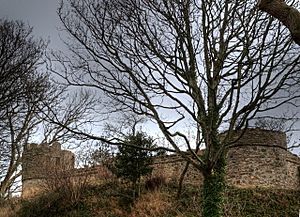
The Kingdom of Wales survived Anglo-Saxon invasions and Viking raids. Eventually, the Kingdom was dismantled by the Normans, beginning with Hugh d'Avranches, Earl of Chester from 1086. Aberffraw Palace was then abandoned, the roof had caved in, and nature took over the building, turning it to ruin. The Llys must have been rebuilt, and there had been a palace in use by Llywelyn ab Iorwerth (Llywelyn The Great), but this structure was eventually disassembled around 1317. As well as the later palace, there was a timber wooden structure on-site and a mound built for a castle type of reinforced fort. As a response to the invasion and by combining the ambition of the House of Aberffraw and its parent house of the Kingdom of Gwynedd, it was the Welsh Princes of Wales who would use their alliances with neighbouring Kingdoms in Wales and the knowledge of Norman / England Kingdom builders to construct many castles throughout the north of the country. In Wales, over 400 castles were built, but only 10% were castles constructed and inhabited by Welshmen. With the advent of stone castles in Wales in the 11th century, the newly built castles did not replace the original Welsh courts (Llys). Most of these new castles were built to protect important routeways and allow cattle farming. Also, Welsh castles were mostly built within locations of strong natural defences, like hilltops or next to a river. It wasn't until the reign of Prince Llywelyn the Great that stone castles were successfully built. During the reign of Llywelyn the Great, grain shipments which were meant to feed Llywelyn's army were blocked from leaving Anglesey by Edward I of England.
During the period of the Norman castle building phase (1088-1277) in Wales, until the invasion of Wales by Edward I was when the majority of native Welsh strongholds were built for the members of the house of Aberffraw. Llywelyn the Great would oversee the construction of the stone castles in the Kingdom of Gwynedd, but these castles were expensive to build. The locations were chosen with military strategy, and for the grazing of animals around Snowdonia, none except Degannwy were built near a Llys. Most Welsh-made castles were built as a direct consequence of the invasion of Llywelyn's father-in-law King John of England and as a response to the Welsh uprising of 1211. With growing infrastructure in Wales, c. 1271, Prince Llywelyn II was ruler to around 200,000 people, this was approximately three-quarters of the total Welsh population.
Norman built castles
The 11th-century Norman invasion started a new wave of castle building and warfare in Wales, having the Normans fighting the invaders, the Welsh, who would in turn sometimes turn on themselves and fight their own kin over succession issues. Norman-built castles such as Gaer Penrhôs and Mold Castle were invaded by Gruffudd ap Cynan's sons and occupied by the Welsh who built new castles on the Norman-built sites; Mold would change sides 5 times over the 12-13th centuries between Welsh and English control, including the castle and the surrounding countryside. Often the Norman castles were destroyed and rebuilt during occupation by the Welsh.
Through rebellions and battles, members of the House of Aberffraw would use Norman estates as personal residences. The Norman castle in Aberlleiniog, Anglesey, was used by Aberffraw Princes, although it was constructed in 1088 by the Earl of Chester. Another example of a Norman castle occupied by the Welsh was Aberystwyth Castle, the Norman stone-built castle was built and inhabited by the Norman Marcher Lord of Ceredigion, Gilbert De Clare. The estate was captured in battle by Owain Gwynedd and his brother Cadwaladr ap Gruffydd in 1121, they invaded Norman-controlled Ceredigion and took 5 castles in the province in the lead-up to the Norman defeat by Welsh forces over a decade later at the battle of Crug Mawr. Aberystwyth was destroyed and later rebuilt by Llywelyn the Great, until it was taken back once more by the Normans and rebuilt by Edward I. In the same year of 1136, after Crug Mawr, Gwynedd and his brother took possession of Cardigan Castle, ousting the 'French and Flemish' people who occupied the castle, and taking spoils of war and prisoners. Despite Owain's bloodthirsty reign, he managed to continue the resistance his father started against the English Crown and was praised by many contemporary writers such as Gerald of Wales for his rule in Wales. His ambition to go to battle successfully meant Wales would keep their independent status. Owain would become the first King of Gwynedd to be styled as Prince, as agreed upon by Henry II of England, he is also considered one of the first Princes of Wales because of his territorial reach throughout the country and was one of the first Welsh leaders not to be seen as a Tribal chief, but as a feudal magnate in Britain. It was Owain's sons who were the first to build stone castles in Gwynedd.
Llywelyn The Great's expedition, 1215
During the reign of Llywelyn the Great, he would start a rebellion against his father-in-law, the King of England, and would take control of several Norman castles in Wales, including Carmarthen, Kidwelly (Cydweli), Llanstephan and Cardigan, (Trefdraeth castle was gifted to him by the family of Cemaes on Anglesey) also Cilgerran castle was given to Llywelyn, all in the year 1215. By the end of Llywelyn's expedition around Wales that year, he also acquired Senghenydd castle, St. Clare and Laugharne (Talacharn). By 1218 the new King, Henry III of England, would confirm Llywelyn's possessions. Other castles taken by the Welsh from Norman possession during the 13th century include, Newport, Loughor, Llandovery, Newcastle, Hawarden and Morlais, while Carndochan was possibly built by Llywelyn the Great.
Welsh built castles
By the 13th century, the Princes of Gwynedd and members of the House of Aberffraw were granted the title Princes of Wales and were the first to build castles all over Wales. The only castles built by the Aberffraw dynasty still standing today are Dolbadarn and Dolwyddelan (Criccieth and Bere castles are partially intact) castles both constructed in 1221 by Llywelyn the Great, who was the most active Welsh castle builder. The other Welsh castles were constructed in the Kingdom of Gwynedd, and now a part of North West Wales. They are, Criccieth, Tomen Castell, Deganwy, Castell Deudraeth (Castell Aber Ia), Carn Fadryn, Castell Pen y Garn, Castell y Bere, all these castles mentioned (except Deganwy, which was first built in the 520s) was used by the House of Aberffraw and built between 1170-1280s (most between 1220 and 1230) within or near borders to the Kingdom of Gwynedd.
Other stone castles were built by the Aberffraw dynasty outside of the Kingdom of Gwynedd from around the year 1150 until the mid to late 13th century. An example was, Castell Cynfael near Tywyn, built by Cadwaladr ap Gruffydd in 1147. A century later, there were Ewloe (started by Llywelyn the Great) and Dolforwyn, both of them built by Llywelyn II, then also Caergwrle Castle was built by his brother, Dafydd III on lands given to him by Edward I. Those three castles were part of the Welsh Marches on the English border within Wales' territory. Other important Welsh-made castles were built in the Kingdoms of Deheubarth and Powys and some in South Wales. These castles were used by members of the House of Aberffraw after victorious battles against their neighbours, which were fellow Welsh Kingdoms as well as Welsh marches Norman Lords (Cambro-Normans). Some castles would be invaded and captured by opposite forces several times over centuries until and after the end of the Aberffraw dynasty in 1283. While the English preferred a rectangular and round tower, the Welsh would build the apsidal or D-shaped tower and a tower (keep) and an enclosure. This architectural design was consistent in Welsh castle builds.
Welsh Principality: Prince of Wales (Welsh rule, 1216 – 1283)
The title, Prince (Welsh: Tywysog) had been in use for several generations by the House of Aberffraw, firstly by Owain Gwynedd who was given the title by the then King of England, Henry II. Llywelyn the Great had been named the Prince of Aberffraw after 1230. The Prince of Wales title was officially conferred by the English Crown in 1216, it was Llywelyn the Great who had received the fealty and homage of the Dinefwr rulers of Deheubarth at the Council of Aberdyfi. As well as in Britain, Llywelyn's reach would include European leaders, and in 1212 a treaty was agreed upon with Philip II of France, and also Pope Innocent III in the Vatican to protect Llywelyn by absolving his promises and oaths to King John of England. With homage and fealty paid by other Welsh lords to him at the Council of Aberdyfi, Llywelyn the Great became the de facto first "Prince of Wales" in the modern sense, though it was his son Dafydd ap Llywelyn who was the first to adopt that title. However, the 1282 Conquest of Wales by Edward I greatly reduced the influence of the family. King Edward I of England forced the remaining members of the family to surrender their claim to the title of Prince of Wales under the Statute of Rhuddlan in 1284, which also abolished the independent Welsh peerage. The Aberffraw family were heirs to the newly formed Principality of Wales, however, the family members closest to Llywelyn II were imprisoned for life by Edward I, or killed in the case of Dafydd III, one Llywelyn the last's younger brothers.
Later Aberffraw claimants
More distant Aberffraw members went into deep hiding and fell into obscurity, some members of the Welsh Royal family did lay claim to the Principality of Wales and thus the title of Prince through their heritage. These men included Madog ap Llywelyn (descendant of Owain Gwynedd) in 1294–95, Llywelyn Bren, Lord of Senghenydd (descendant of Hywel Dda) in 1317, Owain Lawgoch in the 14th century and Owain Glyndwr just over a century later (both Owains were descendants of Prince Llywelyn the Great), Glyndwr proclaimed himself Prince of Wales from 1400. These men had all rebelled against the English who controlled Wales.
English title
From 1301 onwards, less than decades after the end of the House of Aberffraw, the title of Prince of Wales was given to the heir apparent of the King of England, beginning with Edward of Caernarfon, the Anglo-Norman English King to be, who's family it was had invaded, separated and destroyed the very same the Welsh Kingdoms. Today, the title of Prince of Wales is held by Prince William, himself a descendant of Llywelyn the great, this was through the formation of the English House of Tudor (c. 15th century), they claimed Welsh ancestral descent from the Tudors of Penmynydd (descendants of Ednyfed Fychan, Seneschal of the Kingdom of Gwynedd) who had married into the English Royal family. The Prince is also a descendant of Owain Glyndwr through marriage.
Demise, consequences and succession
From Llywelyn the Great, up until his great-great grandson Owain Lawgoch, the royal house of Aberffraw would cease to exist after centuries of turmoil stemming from the Conquest of Wales by Edward I. In less than a year between winter 1282 to Autumn 1283, the two brothers, styled Princes of Wales, Llywelyn the last, and Dafydd III were killed in separate events by the English Crown. Firstly Llywelyn was killed in cold blood at a meeting between English and Welsh forces at the Battle of Orewin Bridge at Cilmeri on the 11th of December, his body was sent to the tower of London. Then, the next year in 1283, after rebelling against English occupation in Wales, Dafydd III was forced into hiding after attacking several castles including Rhuddlan and Hawarden Castles. Then, Dafydd III was betrayed by his own men whilst hiding near Dolbadarn, he was then tried in court for treason against the King of England, then hanged, drawn and quartered in Shrewsbury. After 1283, the next Prince of Wales would be Edward II of England, born in Caernarfon castle in Wales, not of Welsh, but of Anglo-Norman ancestry.
The new Principality era of Wales brought closure to the Welsh customs and laws that were started by Hywel Dda in the year 945. The final direct male descendant (patrilineal) of the dynasty, Owain Lawgoch was Dafydd III's great-nephew (descendant of Llywelyn the Great). Lawgoch's grandfather (Rhodri ap Gruffudd) renounced his rights to Gwynedd and retired to a manor in Tatsfield, Surrey. Owain then spent his childhood in England before becoming a soldier of fortune in France. He unsuccessfully plotted a coup d'état from France to return to Wales and was assassinated in 1378.
Later succession
Several later Welsh families, including the Wynn family of Gwydir (c. 17th century) and the Anwyl of Tywyn family (disputed current head of family) would claim to be heirs of the dynasty, both families were descendants of Owain Gwynedd.
Current succession
To date, The Head of the House of Aberffraw would be given the official title of de jure Prince of Gwynedd. The Royal title is still recognised by the Pope in the Vatican City and also by the descendants of the former Kingdom of France. The position of head of the former Welsh Royal family would be a contender for the original, legitimate and true title of Prince of Wales, the title was last held by Owain Glyndŵr in the 15th century. Currently, the potential head of the house of Aberffraw (also Gwynedd and Wales) is split between 6 Welshmen (one half-French), 2 Irish men, and one Englishman. The debate was recently opened online as of 2022, it will decide who and how the next head of the former ruling family of Aberffraw will be decided. This complex decision could be made in several different ways, it might need to be decided in court, that is through gavelkind, male primogeniture or otherwise.
After the Dynasty
The final patrilineal male descendant of The Aberffraw Dynasty was Owain Lawgoch. Born less than a century after the death of Llywelyn the Great, his hereditary claims as lineal successor ended prematurely in 1378. Merely a century later it was the Meyrick (Welsh: Meurig) family of Bodorgan, Anglesey, who were given the Crown lease for the manor lands of the Aberffraw cantref. Llewelyn Ap Heilyn fought at the Battle of Bosworth alongside Henry VII of England. Also known as Henry Tudor, the King was a descendant of the Aberffraw dynasty via The Tudors of Penmynydd, they descended from Ednyfed Fychan, he was the Seneschal (effectively a Prime ministerial position in government) to Llywelyn the Great and his son Dafydd II. Then Heilyn's son Meurig ap Llewelyn became captain of the bodyguard to Henry VIII and was rewarded with the lease. Today, the same family at Bodorgan Hall (near Aberffraw) is represented by the Tapps-Gervis-Meyrick baronets.
Aberffraw court (Llys) today
Llys Aberffraw had similarities with the neighbouring Llys Rhosyr (a replica is found in St Fagans National Museum of History). Llys Rhosyr was built by Welsh people after the Norman conquest of Wales, which saw Castles and Town Walls of King Edward in Gwynedd built to pacify locals. Llanfaes burgess was moved to Rhosyr from across the island, and the relocation of the town allowed Beaumaris Castle to be built in its place.
The Aberffraw Palace was abandoned after the end of the House of Aberffraw in 1317. The neighboring court, Llys Rhosyr at modern-day Newborough, Anglesey (Southwest Anglesey) was buried by a sandstorm in 1332. Llywelyn II used Rhosyr as an administrative centre. The site was abandoned since then until excavations in the 20th century.
No remains exist from the Llys, however, the 'Palace Garden' (Welsh: Gardd-Y-Llys) is situated in the village. There is also heritage centre at the former site, the aptly named 'Llys Llewelyn' is open to the public as a museum with a tea room.
Biographical sources online
Dictionary of National Biography source
 "Llywelyn_ab_Gruffydd". Dictionary of National Biography 34. (1893). Ed. Sidney Lee. London: Smith, Elder & Co. 13-31.
"Llywelyn_ab_Gruffydd". Dictionary of National Biography 34. (1893). Ed. Sidney Lee. London: Smith, Elder & Co. 13-31.
Dictionary of Welsh biography source
- Pierce, Thomas Jones (1959). "Rhodri Mawr ('the Great') (died 877), king of Gwynedd, Powys, and Deheubarth". Dictionary of Welsh Biography. National Library of Wales.
- Lloyd, John Edward (1959). "Anawawd ap Rhodri (died 916), prince". Dictionary of Welsh Biography. National Library of Wales.
- Pierce, Thomas Jones (1959). "Owain Gwynedd (c. 1100 - 1170), king of Gwynedd". Dictionary of Welsh Biography. National Library of Wales.
- Lloyd, John Edward (1959). "CADWALADR (died 1172), prince". Dictionary of Welsh Biography. National Library of Wales.
- Pierce, Thomas Jones (1959). "Llywelyn ap Iorwerth ('Llywelyn the Great' / 'Llywelyn I', prince of Gwynedd". Dictionary of Welsh Biography. National Library of Wales.
- Lloyd, John Edward (1959). "Dafydd ab Owain Gwynedd (David I, died 1203), king of Gwynedd". Dictionary of Welsh Biography. National Library of Wales.
- Pierce, Thomas Jones (1959). "Llywelyn ap Gruffydd ('Llywelyn the Last,' or Llywelyn II), Prince of Wales (died 1282)". Dictionary of Welsh Biography. National Library of Wales.
- Pierce, Thomas Jones (1959). "Dafydd ap Gruffydd (David III, died 1283), prince of Gwynedd". Dictionary of Welsh Biography. National Library of Wales.
- Pierce, Thomas Jones (1959). "OWAIN ap THOMAS ap RHODRI (' Owain Lawgoch '; died 1378), a soldier of fortune and pretender to the principality of Wales". Dictionary of Welsh Biography. National Library of Wales.


